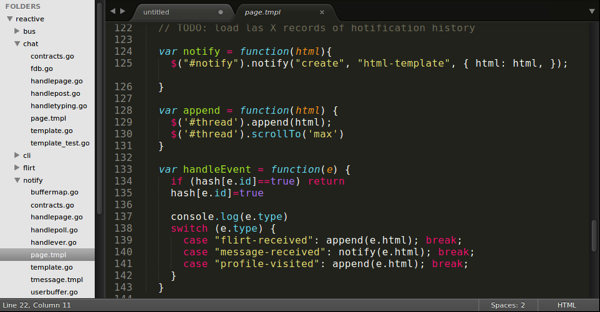Reactive Prototype
Last week, as planned, was quite short but very interesting.
Development of the reactive prototype at some moment hit a complexity point where a dead-simple hacky approach could no longer work. Although go language (with its simple flavor of behavior composition) allowed to go pretty far on that route, in order to move forward, I had to bite the bullet and refactor things from a big ball of mud to a collection of components.
That’s when I realized that I already enjoy coding in golang as much as I enjoyed working with C# in Visual Studio with ReSharper after 8 years of practice in it.

After that refactoring I was able to move forward with the domain exploration (in case of HappyPancake domain includes both the social networking and technical peculiarities of developing reactive application at a social scale).
One of the interesting aspects of the development was the interplay between:
- reactive nature of this prototype (new notifications are rendered on the server and pushed to the client through http polling feed);
- different ways of handling the same event from different contexts and screens (e.g.: a chat message would be appended to the conversation in a chat screen but it will show up as a notification box in another screen);
- different ways of persisting and delivering information to the users (e.g.: chat history is loaded via range read from FoundationDB, while all updates to this history are pushed to the client through the notification feed);
- focus on reducing CPU and latency for the mobile devices (e.g. last 75 messages in a chat come pre-rendered in the page HTML on the first page request, while new messages are pushed incrementally by appending server-generated HTML to the DOM);
- our desire to have graceful degradation of the user experience for some of the older mobile platforms (users could still get some chat experience even if javascript does not work at all).
At this point, I think, we have a pretty good understanding of the domain around messaging and notification feeds. We have:
- a bunch of implementations and use cases captured in the tangible and working code;
- strategy for scaling the performance in a variety of scenarios (with known price to pay for that in terms of complexity or consistency);
- some understanding of how we would deal with devops later on.

Meanwhile, Pieter was working on the other half of HappyPancake
- understanding and developing interactions around document based flows in the social network - registration, logins, profile editing and reviewing. All with PJAX and basic http handlers (we discarded Revel, since it does too much CPU-intensive magic).
Tomas, as usually, focused on backing up our development. He took care of the v1 maintenance, campaigns and also invested in capturing use cases for us to move forward.
It was extremely interesting to sync up with Tomas and Pieter occasionally, sharing concerns and discoveries along the road. It felt like getting an instantaneous deeper insight into the problem we are trying to tackle here.
Another really awesome part of the last week was about gradual transition from purely technical use cases (consistency, availability and latency issues) to practical use cases that matter to our users (flirts, messages, visits etc). Although technology is an important part of HappyPancake, users are the domain that we ultimately trying to understand and master.
The upcoming week will be a bit longer than the previous for me, but still only 4 days (May 9th is another holiday).
We plan to start my prototype into Pieter’s prototype, while moving forward and adding more use cases. I hope to also move forward with newsfeeds. They require a balance between consistency and availability that is different from notifications and chat messages (more like the Instagram news feeds).
Published: May 05, 2014.
Next post in HappyPancake story: Tactical DDD
🤗 Check out my newsletter! It is about building products with ChatGPT and LLMs: latest news, technical insights and my journey. Check out it out